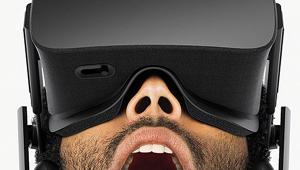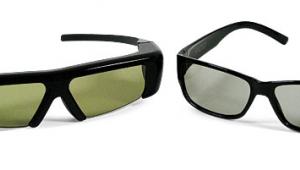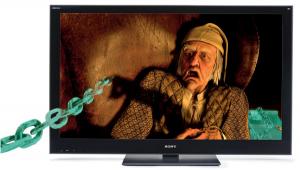This 48fps projection sounds intriguing, but is it pretty much fruitless at this point to expect it to become available at all? They didn't seem to have much success introducing it several years ago, and now I can't imagine a theater chain upgrading their projectors to another film format.
Roger Ebert Hates 3D

1. It's the Waste of a Dimension.
Citing the principle of perspective, Ebert says, "When you look at a 2D movie, it's already in 3D as far as your mind is concerned." That's true to a certain extent, but viewing a 3D movie is a very different experience. Whether or not it's a better experience is highly subjective and depends on how it's done.
He also says, "Adding [a dimension] artificially can make the illusion less convincing." I understand where he's coming from here—the 3D movies I've seen so far rarely let me forget I was watching an artificially created 3D environment—but I'm never fooled into thinking I see real depth in any 2D movie.
2. It Adds Nothing to the Experience.
Here, Ebert says, "Recall the greatest moviegoing experiences of your lifetime. Did they 'need' 3D? A great film completely engages our imaginations. What would Fargo gain in 3D? Precious? Casablanca?" Of course, 3D technology wasn't available—or at least commercially viable—when these movies were made, but what if it had been? Would the filmmakers have used it? I don't know.
These movies don't "need" 3D primarily because they were made without it. Also, many people would cite Avatar as one of the greatest moviegoing experiences of their lives—I've spoken with several—so it's entirely possible for a 3D movie to completely engage our imagination.
3. It Can Be a Distraction.
As Ebert elaborates, "Some 3D consists of only separating the visual planes, so that some objects float above others, but everything is still in 2D. We notice this. We shouldn't." I agree—3D movies often look like stacked 2D planes, much like the flat sets of old live theater. I don't know whether this is a result of inexperienced stereography or an inherent property of the technology.
However, he loses me with his next comment: "In 2D, directors have often used a difference in focus to call attention to the foreground or the background. In 3D, the technology itself seems to suggest that the whole depth of field be in sharp focus. I don't believe this is necessary, and it deprives directors of a tool to guide our focus." There's nothing in the technology that requires an infinite depth of field, and directors are free to change the focus as they wish. I suspect that infinite depth of field is a result of filmmakers' inexperience with 3D.
4. It Can Create Nausea and Headaches.
No argument here. Ebert cites an interview with two ophthalmologists: "As 3D TV sets were being introduced at the Consumer Electronics Show in Las Vegas in January, Reuters interviewed two leading ophthalmologists. 'There are a lot of people walking around with very minor eye problems—for example, a muscle imbalance—which under normal circumstances the brain deals with naturally,' said Dr. Michael Rosenberg, a professor at Northwestern University. 3-D provides an unfamiliar visual experience, and 'that translates into greater mental effort, making it easier to get a headache.' Dr. Deborah Friedman, a professor of ophthalmology and neurology at the University of Rochester Medical Center, said that in normal vision, each eye sees things at a slightly different angle. 'When that gets processed in the brain, that creates the perception of depth. The illusions that you see in three dimensions in the movies is not calibrated the same way that your eyes and your brain are.' In a just-published article, Consumer Reports says about 15 percent of the moviegoing audience experiences headache and eyestrain during 3D movies."
5. Have You Noticed that 3D Seems a Little Dim?
No question about it—the glasses you must wear to view a 3D movie filter a lot of light from reaching your eyes. The cinema standard is 16 foot-lamberts (fL) coming off the screen with no film in the projector, and Ebert claims that most theaters show 3D movies at 3 to 6fL. I don't know if these numbers are correct, but I wouldn't be surprised
BTW, he makes a mistake in his definition of foot-lamberts. He says, "It's the level of light thrown on the screen from a projector with no film in it." Actually, it's a unit of measure of the luminance emitted or, in this case, reflected from a flat, diffuse surface, such as a screen. The amount of light from a projector is referred to as illuminance, which is the total luminous flux incident on a surface per unit area measured in lux or lumens per square meter.
6. There's Money to be Made in Selling New Digital Projectors.
True, but so what? This has nothing to do with 3D per se. Commercial theaters are making the transition from film to digital projection anyway, and 3D doesn't add much if anything to this cost. On the other hand, if a theater installs a polarized 3D system, it must replace the screen with a polarization-preserving material, a significant expense by itself. This is one reason why Dolby 3D might be a better choice, since it does not require a special screen.
7. Theaters Slap On a Surcharge of $5 to $7.50 for 3D.
I think this is a bit exaggerated. I don't know about the rest of the country, but at the AMC multiplex near my home—which has standard film and digital theaters as well as an Imax theater—adult 2D tickets go for $12, while 3D in a standard digital theater adds $3 to $5. Tickets for a 2D Imax movie are $17 ($5 extra), while Imax 3D adds $6 to $7 to the base ticket price. Perhaps Ebert is comparing conventional 2D prices with those for Imax 3D, which is unfair in my book.
On the other hand, any surcharge for 3D might not be justified from a cost-of-presentation perspective. As Ebert points out, "When you see a 2D film in a 3D-ready theater, the 3D projectors are also outfitted for 2D films: it uses the same projector but doesn't charge extra. See the Catch-22? Are surcharges here to stay, or will they be dropped after the projectors are paid off? What do you think?" Clearly, theaters want to make a few extra bucks, even if it doesn't cost them any more to outfit a digital theater for 3D.
8. I Cannot Imagine a Serious Drama, such as Up in the Air or The Hurt Locker, in 3D.
Ebert's inability to imagine this doesn't mean that no one can. And in his extended commentary on this point, he writes, "I once said I might become reconciled to 3D if a director like Martin Scorsese ever used the format. I thought I was safe. Then Scorsese announced that his 2011 film The Invention of Hugo Cabret, about an orphan and a robot, will be in 3D. Well, Scorsese knows film, and he has a voluptuous love of its possibilities. I expect he will adapt 3D to his needs. And my hero, Werner Herzog, is using 3D to film prehistoric cave paintings in France, to better show off the concavities of the ancient caves. He told me that nothing will 'approach' the audience, and his film will stay behind the plane of the screen." Granted, these are not serious dramas as far as I can tell, but still, Ebert seems to be backtracking a bit here.
BTW, I applaud Herzog's intention to keep the "depth" behind the plane of the screen, which will enhance the overall sense of 3D realism. I've always thought that putting things in front of the screen makes the image less realistic and more distracting—in fact, I believe this is the main reason 3D is so often called "gimmicky." Keeping things on or behind the screen is an example of a more mature and refined approach that can go a long way toward encouraging wider acceptance of 3D.
9. Whenever Hollywood has Felt Threatened, It has Turned to Technology: Sound, Color, Widescreen, Cinerama, 3D, Stereophonic Sound, and now 3D Again.
I'm not at all sure about this. It seems to me that Hollywood exploits new technologies whenever they become available because this advances the art of filmmaking, not necessarily because of any perceived threat. As for 3D appearing twice in this list, the technology wasn't as good in the 1950s as it is today, and the movies were schlocky and full of in-your-face gimmickry, which is why it quickly fizzled.
In his commentary on this point, Ebert says, "In marketing terms, this means offering an experience that can't be had at home. With the advent of Blu-ray discs, HD cable, and home digital projectors, the gap between the theater and home experiences has been narrowed. 3D widened it again. Now 3D TV sets may narrow that gap as well." I've often wondered about this myself—3D seems like a good differentiator between commercial and home theaters, yet the studios are as gung ho about bringing 3D to the home as the hardware manufacturers. What's up with that?
He goes on to cite another technology that could offer something not available in the home—48fps movies, which are much smoother and more beautiful than 24fps. (I've seen 48fps, and it's truly amazing.) I would add 4K digital capture and projection as something else that can't be had at home—yet. Of course, 4K displays will reach the home market eventually, but not for a few years.
In the end, Ebert says, "I'm not opposed to 3D as an option. I'm opposed to it as a way of life for Hollywood, where it seems to be skewing major studio output away from the kinds of films we think of as Oscar-worthy... The marketing executives are right that audiences will come to see a premium viewing experience they can't get at home. But they're betting on the wrong experience." For me, the jury is still out on that, but I will continue to closely monitor and report on the entire 3D landscape, which will certainly provide interesting fodder for some time to come.
- Log in or register to post comments

The approach now may be a little different in the presentation, but frankly, unlike others, 3D isn't exactly a new technology and for home use at $250 a "pop" for the glasses on top of the monitor, that could be a consumer killer. People attend an IMAX presentation, especially in 3D, because of the enormous breadth of the experience which could rarely ever be duplicated in the home. Generally, Ebert is right in that a select few movies can take advantage of the format but for most films it would be irrelevant. Once again it is one of those technologies that requires all the "ducks in a row" to become relevant(cost, source devices,along with access to software and programming)before it has a chance, otherwise it will be relegated to the realm of SACD and DVD AUDIO.

The problem with not having infinite depth of field in a 3D presentation is that the 3D leads us to instinctively change our attention to objects at different subjective distances and expect them to be in focus just as in real life. Perhaps with experience one will learn to deal with this.

For me 3D is just gimmickry. I watched Avatar in 3D at movie theater and most of the time the effect is subtle except for the lowering of lumen. I purchased the Avatar 2D Blu-Ray, and i enjoyed it even more than the 3D 2.35 for 2 reasons: first i got much more lumen from my projector,second the movie is in 16:9 (i have a 45X80 inch screen) for me the immersion into the movie (i am 10 feet from my screen) is better in 16:9 than 2:35. my field of vision is more fully filed by 16:9 than by 2:35. I get a better impression of being there in 2D 16:9 than in 3D 2:35. A friend of mine watched Avatar in 3 different theaters, he said than in IMax he got a much better illusion of 3D. I may be wrong, but i believe than IMax screen is rather 16:9. For me 3D already exist if you watch a movie in 16:9 and if your distance from the screen VS screen height ratio is favorable, the illusion of being there is higher, i know, i am repeating myself, but you get the idea

Roger Ebert is reminding me more of an old man unwilling to accept new concepts with every comment he makes. While a may agree with many of his points regarding 3D, he certainly comes across as a person disoriented by new ideas. Considering that this article of his comes shortly after his statement that 'gaming will never be an art', he comes across as one intimidated by anything outside of his definition of normal. Its time for Ebert to retire with his lack of respect for anything he didn't grow up with. I would also like to mention that here in Canada the 3D Glasses ARE $250 for the adult set and $230 for the child's set. Here is a link: http://www.bestbuy.ca/en-CA/product/samsung-samsung-rechargeable-adult-3...

I couldn't agree more with Ebert. Just like Star Wars was heralded as the end of serious cinema--we risk even greater erosion of standards with 3-D consuming EVERYTHING. Sure, 3-D has its place in kid-friendly fare, or over-the-top blockbusters like Avatar, but imagine the Godfather in 3-D??? It adds nothing to a real film. Lets hope the studios know the proper place for the format, and leave anything I would want to watch the hell alone.

Star Wars was thought to be the progenitor for the fall of serious cinema??? Actually, that distinction goes to Jaws, not Star Wars. It is because of Jaws that we have the Summer Blockbuster. Anyway, I thought Avatar looked good in 3D, but I don't see 3D becoming a consumer hit with the public in the home. It's just so expensive.

Jeffrey--yes, Star Wars, not Jaws. I stand by my original post. I don't have to tell you that they are completely different movies. Star Wars started the hollywood trend of fx driven movies, emphasizing sheer entertainment over character-driven substance.

Poor old Roger. Not only is he out of date in what he considers entertaining, he is now out of date in technology. He writes: "Recall the greatest moviegoing experiences of your lifetime. Did they 'need' 3D?" Actually if that remark made sense then we really don't need color either, do we? Many of the greatest movie going experiences were in B & W, not color. And silent too! Many of the greatest films ever made were silent. So I guess we don't need sound now do we, Roger? I say "Keep bringing on new technology."

Many people have mono-vision and actually focus through one eye at a time. 3D causes headaches and discomfort with no 3D effect. Manufacturers should focus on higher resolution and improved audio from smaller sets (Under 32") for example. Save your money.

I'll cite Dial M for Murder as a serious drama in 3D, done marvelously, by a brilliant director. Yes, it also holds up well in 2D, but what non-gimmicky movie wouldn't? While I like the argument that 3D doesn't add much to an experience (it shouldn't), I'd argue back that adding subtler things that we're less conscious of to the viewing experience is *exactly* what us videophiles are into, and that we've all experienced the improvement it can make in the viewing experience. That said, I recently watched Dial M for Murder on a 15" laptop screen that was damaged by dropping the laptop, with a single 1" speaker, and still thought it was genius. Of course the main factor in a movie's quality will never be the technology or the environment in which it's watched! That said, if a movie at the Chinese Theater in LA doesn't do more for you than the same movie at the multiplex, I think Stereophile isn't the right publication for you ;-)

I see many of you missing a key point! Regardless of 3D enhancing a picture like Avatar or a afterthought like Alice In Wonderland, all other picture quality specs are degraded by the glasses,silver screen and 2k low rez or 4k downscaled video! We lose sharpness,brightness,and proper contrast! The way it is going we will be losing good 2d completely because the agenda is to make all screens silver with not ready for prime time digital projection. Film 2d will take a backseat ! Great photography a thing of the past! Even if 3d fails the screens will remain silver and ugly for a long time to come! I also don't want a silver screen in my home theater!

I also agree with EBERT. This is just a scam and a total waste of money!!! It's just another avenue for the manufactures to charge more for their t.v's and like always people get sucked into thinking they NEED IT !! when in fact they would probably rarely use it. I will never purchase one.

The studios are more interested in selling product than they are in supporting commercial theaters. Advancements in technology have traditionally boosted theater attendance at the expense of the television industry, but 3D for the home is coming on so fast that theater owners may not see much return on their investment in upgrading.
























































